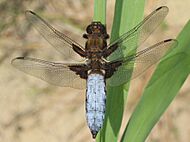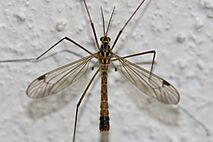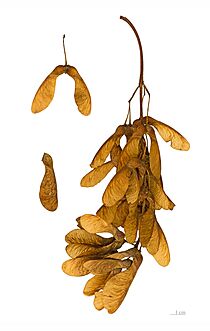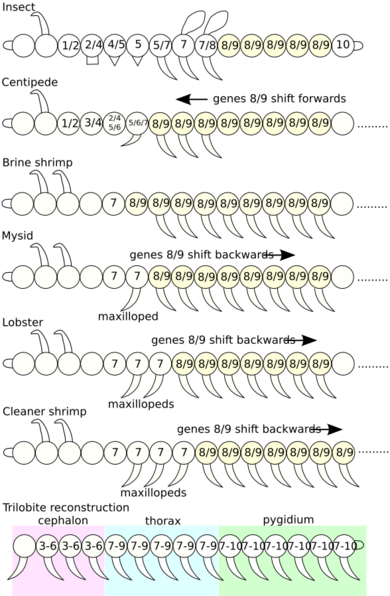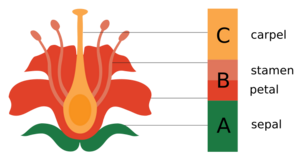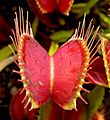Homology facts for kids
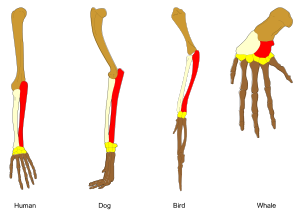
In biology, homology means that different living things have similar body parts or genes because they share a common ancestor. These similarities exist even if the parts now do different jobs. Evolutionary biology explains that these similar structures were kept from a shared ancestor. Over time, they changed to fit different needs through natural selection.
The idea of homology was first used in biology by Richard Owen in 1843. Charles Darwin later explained it with his theory of evolution in 1859. But people had noticed these similarities long before, like Aristotle around 350 BC and Pierre Belon in 1555. A good example is the forelimbs of animals with backbones. The wings of bats and birds, the arms of primates, the front flippers of whales, and the front forelegs of horses and crocodilians all came from the same ancient four-legged ancestor.
In developmental biology, organs that grow in the embryo in the same way are called serially homologous. This means they come from similar starting points in different body parts of the same animal. Examples include the legs of a centipede, the mouthparts of an insect, and the spinous processes (bony bumps) on a vertebrate's backbone.
Sequence homology means that protein or DNA sequences are similar because they share an ancestor. Two pieces of DNA can be related because a new speciation event happened (orthologs). Or, it can be because a gene was copied within the same organism (paralogs). We can guess that proteins or DNA are homologous if their sequences are very similar. If they are very alike, it strongly suggests they came from a common ancestor. Scientists use alignments to find these homologous parts.
Contents
History of Homology
People noticed homology a long time ago. Aristotle (around 350 BC) saw it, and Pierre Belon clearly studied it in 1555. He compared the skeletons of birds and humans in his book Book of Birds. At first, people thought these similarities were just part of a fixed "great chain of being." They didn't think it meant things changed over time.
In 1790, Goethe suggested that flower parts like petals came from leaves. Later, in 1818, the French zoologist Etienne Geoffroy Saint-Hilaire showed that fish, reptiles, birds, and mammals shared similar body structures. He said that the important thing was how different structures were connected to each other.
Embryologist Karl Ernst von Baer noted in 1828 that related animals start as similar embryos. Then they slowly become different. This means animals in the same family are more closely related than animals in the same order.
The word "homology" was first used in biology by Richard Owen in 1843. He studied the similarities in the fins and limbs of animals with backbones. Owen defined homology as "the same organ in different animals under every variety of form and function." He compared it to "analogy," which meant different structures doing the same job. Owen said that to find homologous features, you look at their position, how they develop, and what they are made of.
In 1859, Charles Darwin explained homologous structures. He said they showed that organisms shared a basic body plan from a common ancestor. He saw all living things as branches of a single tree of life.
What is Homology?
The word "homology" comes from Greek words meaning "same relation." It was first used around 1656.
Similar body parts or DNA sequences in different living things are homologous if they came from a common ancestor. This means they changed and became different over time (divergent evolution). For example, many insects, like dragonflies, have two pairs of flying wings. In beetles, the first pair of wings became hard covers. In Dipteran flies, the second pair of wings became small halteres used for balance. All these wing structures are homologous.
Also, the front limbs of ancient animals with backbones have changed a lot. They became the front flippers of whales, the wings of birds, the running front legs of dogs, deer, and horses. They also became the short front legs of frogs and lizards, and the grasping hands of primates, including humans. The same main forearm bones (humerus, radius, and ulna) are found in fossils of ancient fish like Eusthenopteron.
Homology vs. Analogy
The opposite of homologous organs are analogous organs. These organs do similar jobs in two different living things. But they did not come from a recent common ancestor. Instead, they evolved separately. For example, the wings of insects and birds both help with flight. But they developed independently in very different groups of animals. So, they are analogous.
Similarly, the wings of a sycamore maple seed and the wings of a bird are analogous. They both help with flying, but they grew from very different parts. A structure can be homologous at one level but only analogous at another. For example, Pterosaur, bird, and bat wings are analogous as wings. They all fly. But they are homologous as forelimbs. This is because the last common ancestor of these animals had a forearm (not a wing). This forearm then changed in different ways in the three groups.
Homology in Different Animals
Homologies are key to how we classify all living things. Sometimes, these similarities can be very surprising. For example, the pax6 genes control eye development in both animals with backbones and insects. This was unexpected because their eyes look very different and seemed to have evolved separately.
In Arthropods
The body segments of different arthropods (like insects and spiders) have changed a lot. They started from a simple body plan with many similar parts. Now they have fewer segments with special parts. Scientists found the homologies between these parts by comparing genes in evolutionary developmental biology.
| Body part |
Trilobite (Trilobitomorpha)  |
Spider (Chelicerata)  |
Centipede (Myriapoda) |
Insect (Hexapoda)  |
Shrimp (Crustacea)  |
|---|---|---|---|---|---|
| 1 | antennae | chelicerae (jaws and fangs) | antennae | antennae | 1st antennae |
| 2 | 1st legs | pedipalps | - | - | 2nd antennae |
| 3 | 2nd legs | 1st legs | mandibles | mandibles | mandibles (jaws) |
| 4 | 3rd legs | 2nd legs | 1st maxillae | 1st maxillae | 1st maxillae |
| 5 | 4th legs | 3rd legs | 2nd maxillae | 2nd maxillae | 2nd maxillae |
| 6 | 5th legs | 4th legs | collum (no legs) | 1st legs | 1st legs |
| 7 | 6th legs | - | 1st legs | 2nd legs | 2nd legs |
| 8 | 7th legs | - | 2nd legs | 3rd legs | 3rd legs |
| 9 | 8th legs | - | 3rd legs | - | 4th legs |
| 10 | 9th legs | - | 4th legs | - | 5th legs |
Among insects, the stinger of a female honey bee is a changed ovipositor. This is the egg-laying tube found in other insects like grasshoppers and many wasps.
In Mammals
The three tiny bones in the middle ear of mammals, including humans, are the malleus, incus, and stapes. They help us hear by sending sound from the eardrum to the inner ear. In the embryo, the malleus and incus grow from structures that form jaw bones in lizards. Fossils of mammal ancestors also show these jaw bones. Both facts prove that these bones are homologous, meaning they share a common ancestor.
Among the many homologies in mammal reproductive systems, ovaries and testicles are homologous.
Rudimentary organs, like the human tailbone, are now much smaller than they used to be. They are easily understood as signs of evolution. They became smaller because their original job was no longer needed. The tailbone is homologous to the tails of other primates.
Homology in Plants
In many plants, structures for defense or storage come from changes in leaves, stems, and roots.
Leaves, Stems, and Roots
Leaves are changed in different ways from their original job of making food. They can form the insect-trapping pitchers of pitcher plants. They can also be the insect-trapping jaws of the Venus flytrap. Or they can be the spines of cactuses. All these are homologous to leaves.
| Original Parts | Defensive Structures | Storage Structures |
|---|---|---|
| Leaves | Spines | Swollen leaves (e.g. succulents) |
| Stems | Thorns | Tubers (e.g. potato), rhizomes (e.g. ginger), fleshy stems (e.g. cacti) |
| Roots | - | Root tubers (e.g. sweet potato), taproot (e.g. carrot) |
Some compound leaves of flowering plants are partly homologous to both leaves and shoots. This is because their development has changed. It now mixes traits from both leaf and shoot development.
Flower Parts
The four main parts of a flower are carpels, stamens, petals, and sepals. These parts are homologous to and came from leaves. Goethe correctly pointed this out in 1790. How these parts grow is controlled by a pattern of gene expression in the growing zones of the flower. This is called the ABC model of flower development.
Each of the four flower parts is repeated in circles, controlled by a few genes. For example, if only "A" genes are active, sepals form. If "A" and "B" genes work together, petals form. If "B" and "C" genes work together, stamens form. If only "C" genes are active, carpels form. If none of these genes are active, leaves form. These genes are very old, as old as the flowering plants themselves.
Developmental Biology

Developmental biology can show homologous structures that grew from the same tissue in an embryo. For example, adult snakes don't have legs. But their early embryos have small limb-buds for hind legs. These buds soon disappear as the embryo grows. This suggests that snake ancestors had hind legs. This idea is supported by fossil evidence. The Cretaceous snake Pachyrhachis problematicus had hind legs. These legs had hip bones, a thigh bone, leg bones, and foot bones, just like four-legged animals today.
Sequence Homology
Just like body parts, sequence homology between protein or DNA sequences means they share an ancestor. Two pieces of DNA can share an ancestor in two ways:
- Orthologs: If a species splits into two new species, the copies of a single gene in these two new species are called orthologous. This term was created by Walter Fitch in 1970.
- Paralogs: If a gene is copied within the same organism's genome, the two copies are called paralogous. These copies can change the structure of entire genomes and help explain how genomes evolve. For example, the Homeobox (Hox) genes in animals were copied many times. This means Hox genes in most animals with backbones are found on many different chromosomes.
Sometimes, sequences are homologous but have changed so much that their similarity is hard to see. However, many proteins keep very similar shapes. So, scientists can use structural alignment to show they are homologous.
Images for kids
-
One pinnate leaf of European ash
-
Detail of palm leaf
-
Leaf petioles adapted as spines in Fouquieria splendens
-
Succulent water storage leaf of Aloe
-
Insect-trapping leaf of a Venus flytrap
-
Insect-trapping leaf of pitcher plant
See also
 In Spanish: Homología para niños
In Spanish: Homología para niños
- Analogy (biology)
- Primitive (phylogenetics)




